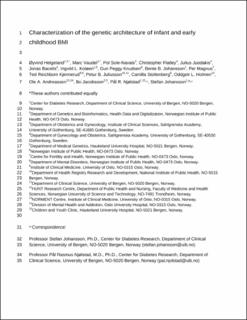Characterization of the genetic architecture of infant and early childhood body mass index
Helgeland, Øyvind; Vaudel, Marc; Sole-Navais, Pol; Flatley, Christopher; Juodakis, Julius; Bacelis, Jonas; Koløen, Ingvild; Knudsen, Gun Peggy Strømstad; Johansson, Bente Berg; Magnus, Per Minor; Reichborn-Kjennerud, Ted; Juliusson, Pétur Benedikt; Stoltenberg, Camilla; Holmen, Oddgeir Lingaas; Andreassen, Ole; Jacobsson, Bo; Njølstad, Pål Rasmus; Johansson, Stefan
Journal article, Peer reviewed
Accepted version
Permanent lenke
https://hdl.handle.net/11250/3009502Utgivelsesdato
2022Metadata
Vis full innførselSamlinger
- Department of Clinical Science [2395]
- Registrations from Cristin [10399]
Sammendrag
Early childhood obesity is a growing global concern; however, the role of common genetic variation on infant and child weight development is unclear. Here, we identify 46 loci associated with early childhood body mass index at specific ages, matching different child growth phases, and representing four major trajectory patterns. We perform genome-wide association studies across 12 time points from birth to 8 years in 28,681 children and their parents (27,088 mothers and 26,239 fathers) in the Norwegian Mother, Father and Child Cohort Study. Monogenic obesity genes are overrepresented near identified loci, and several complex association signals near LEPR, GLP1R, PCSK1 and KLF14 point towards a major influence for common variation affecting the leptin–melanocortin system in early life, providing a link to putative treatment strategies. We also demonstrate how different polygenic risk scores transition from birth to adult profiles through early child growth. In conclusion, our results offer a fine-grained characterization of a changing genetic landscape sustaining early childhood growth.
